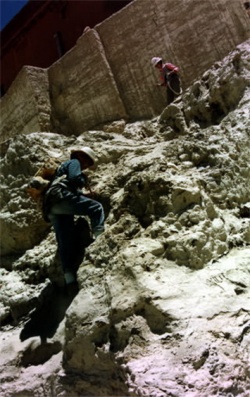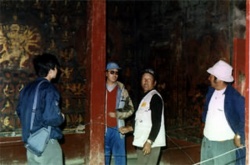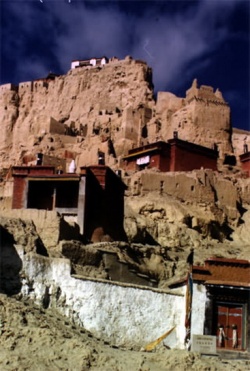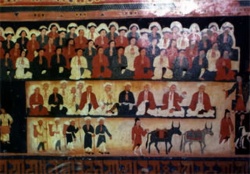Rescuing Ancient Ruins in Ngari
The ruins of an ancient castle are perched along a high terrace on the southern bank of a River basin in Ngari, western Tibet. Some 700 years ago, this was the center of the Guge Kingdom, whose rulers fostered and nurtured the spread of Buddhism. Their kingdom survived and thrived for some 500 years. During this period, many Monasteries and buildings were erected. The ruins and Relics attract numerous Tibetologists and archaeologists. Builders transporting adobe bricks and stones from the foot to the top of the mountains.
With the arrival of the 1970s, archaeologists began to study the history of the Guge Kingdom and the surrounding Zhangzhong culture. A campaign also began to repair and restore the ancient ruins at Ngari.
According to Gyiayang, the director of the Cultural Relics Bureau of the Tibet Autonomous Region, the central government has offered limited funds for the protection of cultural Relics In Tibet, including work on the ruins of the Guge Kingdom and the Donggar Piyang Grottoes.
“However, this small sum has helped very little,” Gyiayang adds, pointing out, “these ruins had been abandoned for more than 300 years.”
“In 1996, the State Cultural Relics Administration and the Cultural Relics Bureau of the Tibet Autonomous Region formed a joint team to inspect the ruins at Ngari. The team produced a schedule for the restoration of the ruins of the Guge Kingdom and the Donggar Piyang Grottoes.
“In March of 1997, a meeting was held in Beijing to discuss the means for the repair of the ruins at Ngari. Soon after the meeting, a team of experts were sent from the State Cultural Relics Administration, the Shaanxi Provincial Archeological Research Institute, the Hebei Provincial Ancient Architecture Research Institute, the China Cultural Relics Research Institute, the Palace Museum and Sichuan Lianhe University.
“In late April of 1997, a restoration team made up of more than 40 people led by Ngawang Lhozhul left Lhasa for Ngari.
In Order to guarantee the accuracy of the renovations, all of the mud and water used in the adobe structures and every rock or piece of lumber came from the local area and was collected by the team under the scorching summer sun. The ruins of the Guge Kingdom, located in Zhada County, are nestled into the mountain slopes skirting the Xianquanhe River. Gyide Nyima, an offspring of the Tubo king Lang Darma, built the city in the early 10th century. The ruins cover an area of 720,000 square meters. They included what remains of over 400 Monasteries and Buddhist halls, 58 castle towers, close to 1,000 Caves, four underground tunnels, 28 dagobas and 11 storage houses and other buildings.
“After the Guge Kingdom was overthrown in the mid-17th century, the city was gradually abandoned,” explains Director Gyiayang. “Thanks to an unusually dry weather, the adobe-stone-wood structures of the ancient castle survived for many centuries.”
“Five buildings, including the Red Hall and the White Hall, are exceptionally well preserved. Inside are frescoes that not only show us something of the culture, but are also of high artistic value.
“However, the ruins fall prey to merciless, heavy rainfall during the rainy season.”
The repair team works very hard on the ruins. Team members check each corner of the ruins. On this basis, they have shifted the drainage of rainwater by filling underground channels and laying pipelines. Efforts have also been made to reinforce the ceilings.
Courtesy of Tibet CULTURAL Relics BUREAU
Herculean efforts were made to repair the Toding Monastery.
The Toding Monastery, located in the seat of Zhada County, was built against a clay mountain along the banks of the Xianquanhe River. It includes Buddhist halls, intact dagobas, broken dagoba walls and the living quarters of the Monks. It is famous among the Tibetans because it was once the residence of Master Adisha and the venue of the Grand Summonsing Ceremony held in the Year of the Dragon. The Monastery is known to all In Tibet and is a cultural relic under national protection.
The repair of the Monastery demanded incredible efforts since it is still a functioning Monastery and many Monks live on the grounds. Fresco in a Donggar cave
The renovation and restoration team was able to restore much of the Monastery to its original condition and to partially restore some other areas.
The Donggar Piyang Grottoes have been repaired over a period of prolonged preservation.
The Donggar Piyang Grottoes, spread along a 30-kilometer narrow clay cliff to the northeast of the Zhada county seat, are actually located in two villages. The Donggar and Piyang villages are both under the jurisdiction of Donggar Township. The two villages are two kilometers apart.
The grottoes in Donggar are found on a mountain slope 500 meters north of Donggar Village. They are actually three niches along a row. The tops of the grottoes are square outside and round inside, in the shape of Mandalas. The frescoes in the grottoes are surprisingly well preserved, to the delight of visitors.
The renovation of the Donggar Grottoes has focused on reinforcing the grottoes walls and further protecting the frescoes. A drainage system has been laid in Order to aid in this work. Fresco in the Red Palace of the Guge Kingdom
The grottoes in Piyang are found on a mountain slope 500 meters west of Piyang Village. The clay mountainside is nearly entirely covered with Buddhist grottoes, dagobas, and Buddhist halls. Efforts have been made to restore the Sutra halls and grottoes where part of their frescoes are well preserved.



